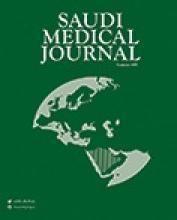Abstract
Kimura’s disease is a rare, chronic inflammatory condition of unknown etiology; with a predilection in the head and neck region. However, the involvement of the lip and epiglottis is extremely rare, and poses a diagnostic challenge. Here, we report a case of a 32-year-old Saudi male presenting with lip mass and epiglottic swelling without any history of hoarse voice or airway compromise. Serology showed elevated immunoglobulin E levels, and histopathological examination of biopsied lesions revealed well-developed lymphoid follicles with eosinophilic infiltration confirming Kimura’s disease. At the time of last follow-up, his condition was satisfactory without any signs of recurrence.
Kimura’s disease (KD) is a rare, chronic non-neoplastic inflammatory disease, that is predominantly seen in Asian males during the third decade of life.1 The common manifestation is slowly enlarging subcutaneous masses often found in the head and neck region along with raised serum immunoglobulin E (IgE) levels, and peripheral blood eosinophilia. Kimura’s disease affecting lips and larynx is an extremely rare entity, and only few case reports have been published.2 Here, we report a rare case of KD affecting lip and epiglottis and its related review of literature.
Case Report
A 32-year old Saudi male presented with an 8-year history of upper lip swelling without any hoarseness of voice, and airway compromise. His previous medical and surgical history was unremarkable. On physical examination, a diffuse, solitary hard upper lip mass of size 2×1.5 cm was noticed without any significant cervical lymphadenopathy. The rest of the examination was unremarkable. The complete blood count showed eosinophilia (eosinophils; 11%), and serological examination showed elevated serum IgE with a value of 1064 IU/mL. Magnetic resonance imaging of the head and neck exhibited a 2×2 cm upper lip mass (Figure 1A), and CT scan of the neck showed a polypoid mass measuring 2.5×2 cm attached to the epiglottis (Figure 1B). He underwent excision of the lip and epiglottic lesions. Histopathological examination showed multiple hyperplastic lymphoid follicles with reactive germinal centers beneath the intact stratified squamous epithelium of the epiglottis (Figure 2), and adjacent to the minor salivary gland of the lip (Figure 3). The lymphoid follicles were separated by mixed chronic inflammatory infiltrate with a large number of eosinophils along with plasma cells, small mature lymphocytes, as well as histiocytes (Figures 4 & 5). His condition was satisfactory without any signs of recurrence.
An image showing: A) the sagittal view of MRI of the head showing upper lip mass; and B) CT scan of the neck showing epiglottic mass.
An image showing hyperplastic lymph follicles beneath the squamous epithelium of the epiglottis (Hematoxylin & Eosin, original magnification ×100).
An image showing lymph follicles adjacent to the minor salivary gland of the lip (Hematoxylin & Eosin, original magnification ×100).
An image showing interfollicular area infiltrated by mixed inflammatory cells and thin walled blood vessels (Hematoxylin & Eosin, original magnification ×400)
An image showing interfollicular area infiltrated by mixed inflammatory cells and eosinophils (Hematoxylin & Eosin, original magnification ×400)
Discussion
Kimura’s disease was initially described in 19373 as “eosinophilic hyperplastic lymphogranuloma”. In 1948, Kimura et al4 reported it with a title ‘‘On the unusual granulation combined with hyperplastic changes of lymphatic tissue’’ after which this entity became widely known as KD.4 Kimura’s disease tends to affect predominantly young adults, and shows a striking male predilection (male to female ratio was 5:1).5 The diagnosis of KD is challenging. The main differential diagnosis of KD is angiolymphoid hyperplasia with eosinophilia (ALHE).
Kimura’s disease invariably is associated with peripheral eosinophilia, and elevated serum IgE levels. The solitary lesions are usually in the deep subcutaneous tissues, frequently associated with regional lymphadenopathy, and salivary glands involvement. By contrast, ALHE occurs mainly in females, and patients present with small, superficial dermal papulo-nodules, frequently erythematous, accompanied by bleeding, pruritus, and tumor growth, without regional lymphadenopathy, serum eosinophilia, and elevated IgE levels.5 Also in contrast to KD, the vascular proliferation is most commonly seen in ALHE.5,6 Kimura’s disease of the lips was reported in 16 cases.7 Similarly, KD of the epiglottis is also extremely uncommon; only 11 cases have been reported in the literature.8 Symptoms were mostly related to airway narrowing, and only 2 patients were found asymptomatic, which is similar to our case.7 Further, the co-existence of the lip and epiglottic KD is not previously reported.
The pathogenesis of KD is not well known; however, allergic reaction or an alteration of immune regulation can be the possible cause.8 Surgical resection is the standard treatment option for KD. Adjuvant therapy in the form of steroids, cytotoxic therapy, and radiation therapy also have been used in some cases.9 Kimura’s disease is associated with excellent prognosis; only few local and distal recurrences also have been reported.10
In conclusion, KD of the lip and epiglottis is extremely a rare manifestation and poses a diagnostic challenge. Surgical resection is the treatment of choice.
Case Reports
Case reports will only be considered for unusual topics that add something new to the literature. All Case Reports should include at least one figure. Written informed consent for publication must accompany any photograph in which the subject can be identified. Figures should be submitted with a 300 dpi resolution when submitting electronically or printed on high-contrast glossy paper when submitting print copies. The abstract should be unstructured, and the introductory section should always include the objective and reason why the author is presenting this particular case. References should be up to date, preferably not exceeding 15.
Acknowledgment
The authors gratefully acknowledge Mohammad U. Manzoor, Consultant Radiologist, for reviewing the images and providing excellent feedback.
Footnotes
Disclosure. Authors have no conflict of interests, and the work was not supported or funded by any drug company.
- Received May 6, 2015.
- Accepted August 11, 2015.
- Copyright: © Saudi Medical Journal
This is an open-access article distributed under the terms of the Creative Commons Attribution-Noncommercial-Share Alike 3.0 Unported, which permits unrestricted use, distribution, and reproduction in any medium, provided the original work is properly cited.











